
It’s October and the birch and cottonwood leaves color the ground yellow outside, while the annual flowers planted around Anchorage have been pulled up. The termination dust has already frosted the peaks of the Chugach Front Range, and it won’t be long before winter arrives. So what is a plant enthusiast to do during the dark and cold winters in south-central Alaska?

One solution is to visit the Mann Leiser Memorial Greenhouse in Anchorage. Operated by the Municipality of Anchorage from 8:00 am to 3:30 pm daily, the two adjoining greenhouses offer a slice of tropical paradise to help alleviate those winter blues. Located at 1321 Lidia Selkregg Lane, the facility is free and open to the public.
In this post I will highlight eight of the plants on display, discuss their origins and ideal growing environments, and provide tips for growing indoor tropical plants for yourself.
1. The Solarium

Heat, humidity, and light greet you as you step in from the cold and enter the Solarium. This glass-enclosed greenhouse is a great place for therapeutic exposure to light. This solarium also includes an aviary with finches, parakeets, and cockatiels, and a split-level pond with koi fish. The ambient room temperature is 70 degrees Fahrenheit.
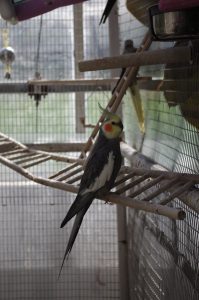
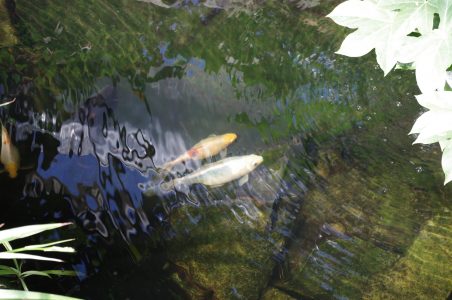
While walking through the solarium, see if you can find these plant species:
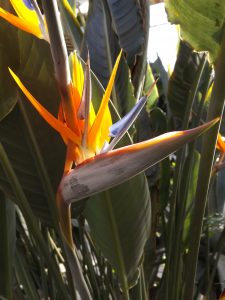
Bird of Paradise (Strelitzia reginae) belongs to the Musaceae family, the same family as bananas, and originates from South Africa. The flowers develop in spring, and often again in the fall, atop a long stalk above a green, keel-shaped bract in an almost-horizontal position from which bright orange flowers with a violet tongue grow. Be patient, as it often takes 4-6 years before the plant begins flowering. Bird of Paradise prefers 3-4 hours of bright light daily, but not direct summer sun. During its growth period, let the surface of the soil mixture become dry before watering, but during dormancy, avoid letting the soil dry out. During the winter, temperatures can be reduced to 55-60 degrees Fahrenheit.
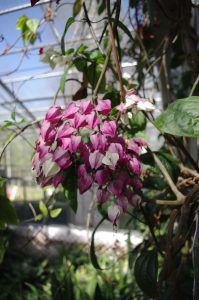
Bleeding-heart vine (Clerodendrum thomsoniae) belongs to the Lamiaceae family, the same family as mint and coleus, and is also commonly known as bleeding glory-bower. This woody, vine species is native to tropical west Africa from Cameroon west to Senegal and is an evergreen liana. The climbing stems reach well over 8 ft. here, but it can be trained as a bush or hanging basket if pinched. The flowers are produced in cymes of 8-20 together, each flower with a pure white to pale purple calyx and a deep-red corolla. This species prefers average warmth around 70 degrees Fahrenheit in the growing season and cooler temperatures (55-60 degrees Fahrenheit) during the winter. It will benefit from high air humidity and bright but not direct sunlight. Keep the soil moist throughout the spring and summer, and water sparingly in the winter.
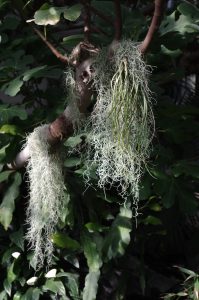
Spanish moss (Tillandsia usneoides) belongs to the Bromeliaceae family, which means that it is not a moss or a lichen but actually a flowering bromeliad. Spanish moss is an epiphyte, so it grows on the surface of another plant and absorbs water and nutrients through its leaves from the air and rainfall. It is native to the Americas from Virginia south through the Caribbean to Argentina and thrives in high-humidity environments growing on branches in full sun through partial shade. The flowers are inconspicuous, and it propagates via seed, vegetatively via wind, or carried by birds using it to make their nests. With fertilized water, mist Spanish moss daily with a 2 gallon-per-minute spray nozzle. This bromeliad also grows well on pieces of hanging driftwood.
2. The Tropical House

After ascending through the solarium, you enter the much larger Tropical House and are greeted by a vast array of plants from around the world. The ambient room temperature is 70 degrees Fahrenheit.
While perusing the botanical collection, see if you can find these plant species:
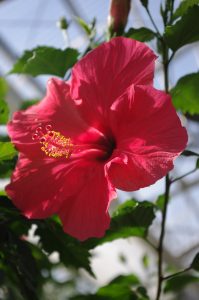
China rose (Hibiscus rosa-sinensis) is an evergreen shrub or small tree native to east Asia and belongs to the Malvaceae family (the mallow family), so it is not actually closely related to the true roses. It is also commonly known as Chinese hibiscus, Hawaiian hibiscus, and shoeblackplant. China rose needs a minimum of 55 degrees Fahrenheit in winter and average warmth in the summer (70 degrees Fahrenheit) and prefers brightly-lit conditions and the occasional misting of its leaves. The large, showy flowers only last a day or two, but the species will have a succession of blooms from spring through autumn. Try to keep the soil moist at all times during the growing season and reduce watering in the winter. To propagate, take tip or stem cuttings 4 inches long between April and July and plant in a moist mixture of peat and sand in equal parts. Enclose the container in a plastic bag and keep in filtered light at 61 degrees Fahrenheit. After rooting, remove the plastic bag and begin watering, remembering to fertilize every two weeks.
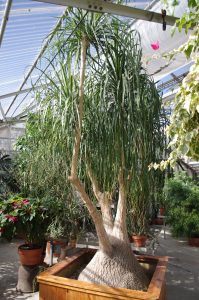
Ponytail palm (Beaucarnea recurvata) is native to eastern Mexico and belongs to the Asparagaceae family. Also known as elephant’s foot, this evergreen perennial is not actually closely related to the true palms. This species prefers full sun to light shade and does not like being over-watered. After approximately ten years, it will produce small panicles of white flowers.

Golden shrimp plant (Pachystachys lutea) belongs to the Acanthaceae family and is native to Central and South America. It is also commonly known as lollipop plant. This evergreen species has golden bracts with white blooms and will continue to flower from late spring through autumn. It prefers a brightly-lit spot away from direct sun in the summer, average warmth in summer, and a minimum of 55 degrees Fahrenheit in winter. Water liberally during the growing season and mist leaves during summer; water sparingly in winter.

Powder puff tree (Calliandra haematocephala) belongs to the Fabaceae family (the pea family) and was first found in Bolivia. The namesake flowers are made up entirely of stamens. This tree species needs a minimum of 60 degrees Fahrenheit in winter, and as much light as possible. Keep the soil moist at all times in summer and mist the leaves frequently during the growing season; reduce watering in winter. To propagate, take stem cuttings in spring, use a rooting hormone, and provide bottom heat.
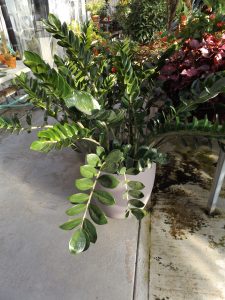
Zanzibar gem (Zamioculcus zamiifolia) belongs to the Araceae family (the arum family) as is native to eastern Africa from Kenya south to northeastern South Africa. This tropical perennial herb species is also commonly known as Zuzu plant, emerald palm, and eternity plant. Although it may look plastic, this plant is a hardy succulent and the only member of its genus. Like other members of the arum family, Zanzibar gem produces a spadix flower. The spadix of Zanzibar gem is small and bright yellow to brown to bronze and hidden near the leaf bases. This species makes a great houseplant because it can tolerate low light levels and very long intervals between watering; indeed, it dislikes being over-watered. It prefers bright, indirect light and minimum winter temperatures above 59 degrees Fahrenheit and summer growing temperatures between 65 and 79 degrees Fahrenheit.
3. Trouble in Paradise

In the Land of the Midnight Sun, plants grow copiously during the summer months. A common issue you might encounter while growing indoor tropical plants in Alaska is root-bound plants and the subsequent lack of drainage which leads to chlorotic (yellow) leaves and root rot. To ameliorate the effects of a root-bound plant, remove the plant from the container (use a rubber mallet to tap the top and sides of the pot if the plant is stuck in the pot) and use a pruning saw to cut off the lower portion of root growth and side root growth if necessary. Use your hands to loosen the remaining root mass and re-pot the plant in a larger pot with fresh potting soil, leave an adequate amount of freeboard (space between the top of the pot and soil level), and water thoroughly. For plants showing symptoms of chlorosis and when re-potting is not possible, use an electric hand drill to create at least one, if not multiple, holes into the base of the container to allow water to flow through and out of the soil.
4. Get Your Fill of Chlorophyll
Alaska is notorious for its long, dark, and cold winters, but if you’re in the Anchorage area, one step into the Mann Leiser Memorial Greenhouse will transport you to a tiny, tropical world. Here you can take off your winter coat and bask under the lights amidst tropical plants from distant lands. Beyond the plants highlighted in this post, hundreds of other plants including cacti, euphorbias, agaves, haworthias, and orchids are just waiting to be enjoyed. Often, plant cuttings are available by the entrance, and if so, you can bring a piece of paradise back to your home and create your own slice of tropical Alaska.
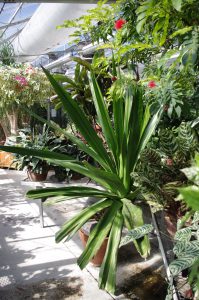

5. References
Chiusoli, Alessandro, and Maria Luisa Boriani. Simon and Schuster’s Guide to House Plants. Simon and Schuster, 1986.
Hessayon, D. G. The New House Plant Expert. PBI Publications, 1991.
Dortort, Fred. The Timber Press Guide to Succulent Plants of the World. Timber Press, 2011.
All photos contributed by the author, Cormac N. Griffin.